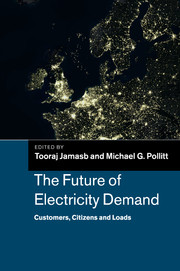Book contents
- Frontmatter
- Contents
- List of Figures
- List of Tables
- List of Boxes
- List of Contributors
- Foreword
- Preface
- Acknowledgements
- Introduction and overview of the chapters
- Part I The economics
- Part II Technology
- Part III Social dimensions
- Part IV Policy and regulation
- 14 Demand-side management strategies and the residential sector: lessons from the international experience
- 15 Electricity distribution networks: investment and regulation, and uncertain demand
- 16 The potential impact of policy and legislation on the energy demands of UK buildings and implications for the electrical network
- 17 The ADDRESS European Project: a large-scale R&D initiative for the development of active demand
- 18 Daylight saving, electricity demand and emissions: the British case
- 19 Concluding reflections on future active networks and the demand-side for electricity
- Index
- References
18 - Daylight saving, electricity demand and emissions: the British case
from Part IV - Policy and regulation
Published online by Cambridge University Press: 05 March 2014
- Frontmatter
- Contents
- List of Figures
- List of Tables
- List of Boxes
- List of Contributors
- Foreword
- Preface
- Acknowledgements
- Introduction and overview of the chapters
- Part I The economics
- Part II Technology
- Part III Social dimensions
- Part IV Policy and regulation
- 14 Demand-side management strategies and the residential sector: lessons from the international experience
- 15 Electricity distribution networks: investment and regulation, and uncertain demand
- 16 The potential impact of policy and legislation on the energy demands of UK buildings and implications for the electrical network
- 17 The ADDRESS European Project: a large-scale R&D initiative for the development of active demand
- 18 Daylight saving, electricity demand and emissions: the British case
- 19 Concluding reflections on future active networks and the demand-side for electricity
- Index
- References
Summary
Introduction
In the years following the introduction of official standard time in the nineteenth century, efforts to promote daylight saving time were resisted in Britain and elsewhere in the world. Daylight saving time (DST) was finally introduced under wartime conditions in the twentieth century to save fuel. But only recently has the urgency of energy issues redirected attention to the issue of DST and electricity demand. A review of the literature on the impact of daylight saving on electricity demand shows that those advocating a change in DST are charged with providing detailed proof of expected energy benefits, while the assumed benefits of historic standard time are taken as given. Britain provides a case study of institutional inertia in this domain (Cronin and Garnsey, 2007).
We take up the British case in this chapter. After a brief review of the literature on the impact of DST on electricity demand, we report here on a modelling exercise undertaken using National Grid data to estimate the electricity savings that would result from a change in the clock time regime in Britain. The study demonstrates the change in electricity demand that would result from extending daylight saving over the months when clock time is currently on Greenwich Mean Time (GMT). Effects of advancing the current clock-regime by an additional hour are also estimated, using an experimental method.
- Type
- Chapter
- Information
- The Future of Electricity DemandCustomers, Citizens and Loads, pp. 445 - 463Publisher: Cambridge University PressPrint publication year: 2011
References
- 1
- Cited by

